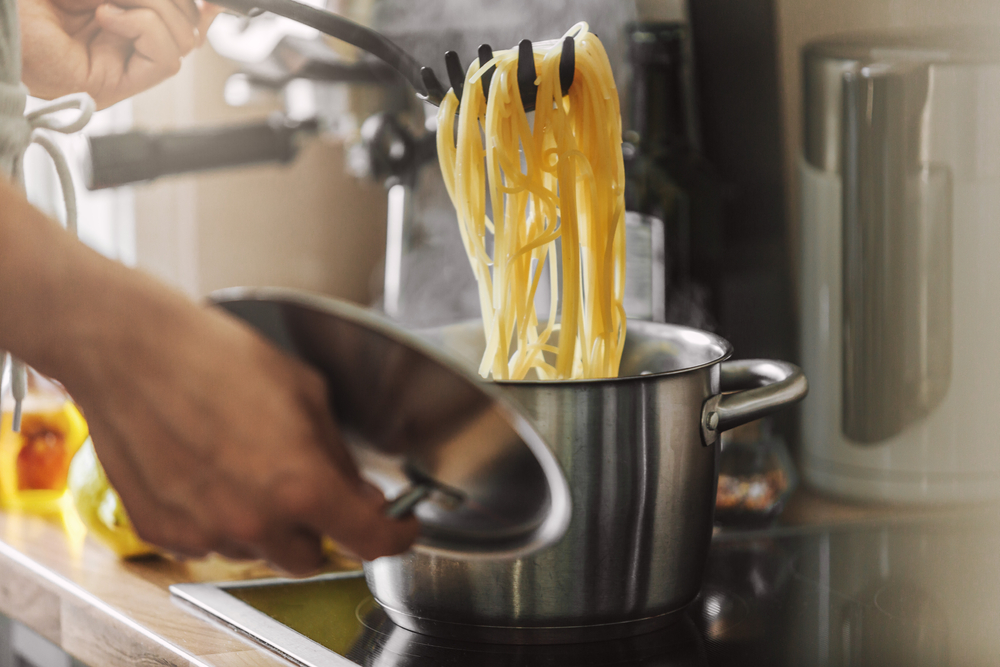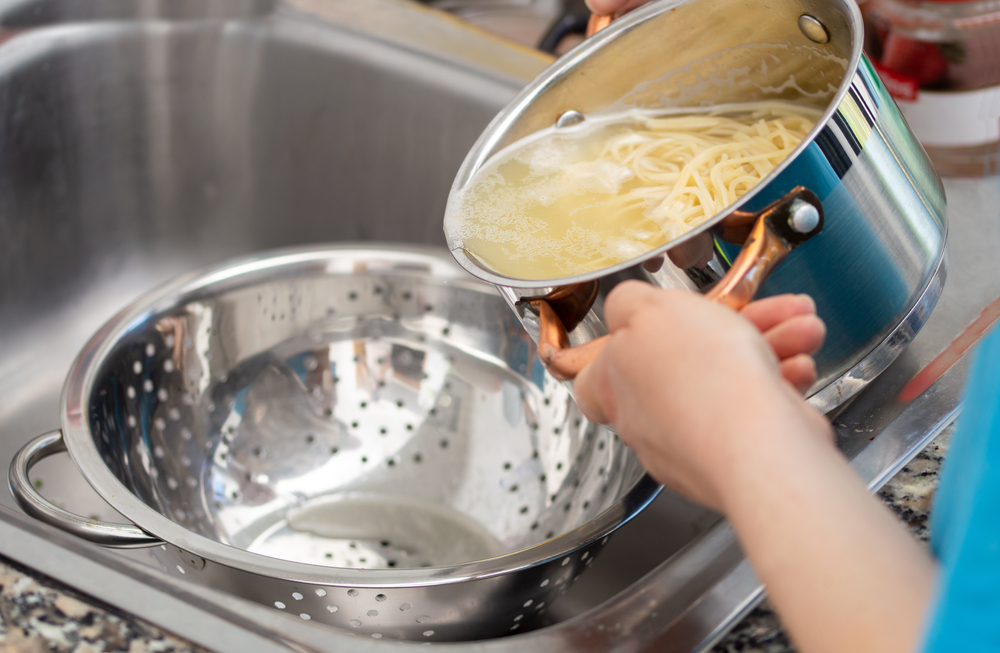Spaghetti is a beloved staple of Italian cuisine. While many believe Marco Polo brought pasta to Europe during his journey through the Far East in the late 13th century, evidence shows otherwise.
According to the Spaghetti Museum, which can be visited in Pontedassio, Imperia, Italy, there are several documents dating from 1279 and 1284 (Polo returned to Italy only in 1292), which refer to pasta, vermicelli (similar to spaghetti but thinner) and maccheroni.
Whatever its history, spaghetti has come to represent Italian cuisine. It is often served with classic tomato sauce and cooked al dente, which means “to the tooth” in Italian. It is also served with clams (spaghetti alle vongole); with oil and garlic (spaghetti aglio e olio); with pork, salty cheese, and eggs (spaghetti alle carbonara); and meatballs, which is a signature Italian-American pasta recipe, spaghetti and meatballs.
Whether you are cooking standard spaghetti, spaghettini, a thinner version, spaghettoni, a thicker spaghetti, or capellini, super-thin spaghetti, here are 14 common mistakes everyone makes!

1. Buying a Cheap Spaghetti Brand
Italian chefs always recommend choosing a quality dry pasta brand. According to some of them, buying a cheap store brand is one of the biggest mistakes you can make when cooking spaghetti. “Bargain basement brand pasta ends up tasting like you boiled the package along with the pasta”, says chef Francine Segan.
The best quality store-bought spaghetti will cook evenly due to uniform thickness and won’t have a starchy pellicle on its surface upon draining, thanks to superior quality flour.
Also, you may want to know that the best pasta is made from just a few ingredients. The top brands use semolina flour, a high-quality, high-gluten flour made from the finest hard durum wheat. Semolina flour is yellow, and it’s packed with gluten protein.
When you’re doing groceries, look for bright yellow spaghetti with a bronze die-cut; these are usually the signs that it’s a quality brand. Make sure to store the pasta in an airtight container to ensure freshness, and always remember to check the expiration date before buying it.
2. Not Salting the Water
Chances are you don’t add enough salt to your pasta water. That would be one of the biggest mistakes when cooking spaghetti, so remember to never skip the salt.
In fact, salt is the universal flavor improver, and pasta will absorb it from the water, boosting flavor from the inside out. You definitely won’t want to oversalt your water; even so, adding the proper salt proportion is one of the most essential steps in the pasta-making process.
Too little salt, on the other hand, will lead to bland spaghetti, which cannot be improved no matter what type of sauce is added.
So, how much salt should you add to reach perfectly seasoned pasta? Well, there isn’t a right answer as it’s down to personal taste. This being said, 1 ½ tsp. of table salt per every quart of water is recommended.
Experiment with the recommended amount of salt, adding less or more of it, until you obtain the perfectly salted spaghetti that matches your tastes. Add less salt if you want to cut back on sodium; more salt if you enjoy a saltier flavor.
3. Not Filling the Pot With Enough Water
Filling the pot with the right amount of water is key to preventing your spaghetti from clumping up or overcrowding. Enough water at a rolling boil in a big pot also returns to a boil faster after you add your pasta, which makes the temperature drop. A roomy pot filled with the right amount of water also makes it super easy to immerse long spaghetti noodles.
So how much water should you actually use to cook spaghetti? According to culinary experts, the average recommended water proportion for pasta is 4 quarts of water for 1 pound of pasta. However, several chefs recommend using 6 quarts of water per every pound of pasta.
As a rule of thumb, fill your pot with 4-6 quarts of water to ensure your pasta has enough room so the noodles won’t stick together in clumps. This will also help your water return to a boil more quickly, ensuring even cooking.
4. Not Using a Large Enough Pot To Boil the Pasta
When it comes to cooking spaghetti, the size of your pot really matters. If you use a too-small pot to boil your pasta, your raw noodles will lower the water temperature abruptly, making it challenging to reach al dente perfection.
If the spaghetti doesn’t have enough room to move in the boiling water, your cooked noodles will result in a gummier and starchier bite. That happens when the starch sticks to the noodles instead of dissolving.
The best option is to choose an 8-quart-sized pot and add 3⁄4 of the way following the recommended 4-6 quarts of water per every pound of spaghetti. If you live with spaghetti enthusiasts, choose an even bigger pot: 8- or 12-quart pots are the ideal choice for boiling larger amounts of noodles.
Be aware that you must use a certain pot with a flat bottom if you have an induction or electric cooktop.

5. Adding Oil to the Water
Myth: you should add olive oil to the water before immersing your spaghetti. We’re here to debunk this age-old myth. The reason why you shouldn’t add olive oil to your pasta water is simple: it’s unnecessary. This step was initially believed to prevent the noodles from sticking together.
However, in order to avoid that, you just have to make sure your pasta is cooked in a large pot of water. Adding oil to the pot of water is simply a waste of energy and precious oil. Worse, when you drain your pasta, the oily film in the pot sticks to the spaghetti, making it more difficult for the sauce to stick to the pasta.
Skip the oil and make sure your noodles are cooked in a large pot filled with the right amount of water at a roaring boil.
6. Immersing Spaghetti Before the Water Reaches a Rolling Boil
One of the most important things to remember when cooking pasta is to never add them to water that hasn’t reached a rolling boil. Spaghetti must be boiled in water at a rolling boil to be perfectly al dente; a rolling boil also prevents the pasta from clumping together.
What’s the difference between a rolling boil and a simmer? An aggressive boil, known as a rolling boil, happens when active bubbles cause the water to vigorously “roll”, which makes the pasta bounce around the pot. You can also hear the water boiling as the bubbles fight their way to the surface.
When you submerge spaghetti (or any pasta) in boiling water, the water temperature will drop a bit, so it’s important to ensure the liquid is actually boiling. The active, rolling bubbles, along with heat, will prevent clumping and guarantee that the noodles are cooked evenly.
7. Not Stirring To Keep It From Sticking
Not stirring the pot is definitely a huge mistake! The Italian food experts advise doing this within the first 2-3 minutes of cooking pasta. Sometimes, dried spaghetti can stick to the bottom of the pot. Not to mention that spaghetti noodles tend to clump together within the first minutes of the cooking process, before the starches are released into the liquid.
Once you add the spaghetti to the pot, give it a swirl to prevent it from clinging to the bottom. Let the water boil for two minutes, then stir again twice to prevent the pasta from clumping together.
Once the liquid returns to a rolling boil, the bubbles keep it in motion, and the noodles separate, which will help them cook evenly.
The best tool for this job is a long wooden spoon: it’s dishwasher safe, easy to clean, and naturally antimicrobial.

8. Not Testing the Spaghetti 2 Minutes Before the Suggested Cook Time
Pasta tastes better when it’s perfectly cooked al dente, which means the spaghetti is tender but still has a somewhat firm texture. The starch found at the very center of the al dente pasta is only partially hydrated, so the spaghetti keeps having a slightly firm bite.
To ensure that your pasta is perfectly al dente, test it about 2 minutes before the suggested cook time. As you bite into the noodle, you should notice a hint of white in the center of it; the noodle should also be somewhat firm, but not crunchy.
Some folks believe that throwing a spaghetti noodle against the wall is an excellent technique to determine whether the pasta is al dente. If the noodle sticks, the pasta tests for al dente perfection, which means the legend stands. However, this method is a myth, not to mention that an overcooked, mushy noddle can also stick to a wall.
Try instead to test the pasta by biting into a noodle a couple of minutes before the suggested cooking time.
9. Overcooking Spaghetti
Overcooked, mushy pasta is definitely among an Italian chef’s worst nightmares. As a rule of thumb, spaghetti should be evenly cooked yet still firm. When you add pasta to the pot, set a timer to prevent overcooking noodles.
Follow the suggested cook time usually mentioned on your pasta package: in most cases, most brands of spaghetti brands cook in 8-10 minutes but check the box for a precise recommended cooking time. Don’t forget to test a noodle 2 minutes before the suggested cooking time is up. Pasta should be the last thing to deal with when cooking your meal since it’s done in mere minutes.
Not only does overcooked pasta taste bad, but it also has fewer nutrients. According to experts, the bonds between the overcooked pasta molecules are damaged, which leads to nutrient loss, too. As a result, overcooked noodles will lose vitamins B5 and B1, as well as amino acids.
10. Not Draining Spaghetti Properly
A recent social media post that went viral shows the latest pasta cooking ‘hack’. The boiling pot of pasta is shown in the video, with a colander being placed over it. The pot is tipped over the kitchen skin to drain the pasta water. This may be a way of draining spaghetti, but it’s also unnecessarily complicated and risky.
Ditch the colander and use tongs instead to move the noodles directly from the pot into the sauce. This method will undoubtedly add some starchy pasta liquid to your sauce but don’t worry, it will enhance the flavor.
Alternatively, you can put a large colander into your kitchen sink, grab the pot using the potholders and pour the pasta into the colander. Don’t forget to save some pasta water for the sauce. Another option implies using a spider strainer and following the same steps mentioned above.

11. Ditching the Pasta Water
Pasta water tends to be overlooked, which is a huge mistake when cooking pasta. This liquid that some home cooks mistakenly throw away is actually an unexpected gem. Always save at least a cup of pasta water to mix with your sauce.
You’ll see that the pasta water is cloudy; that’s because of the lingering salts and starches imparted from the spaghetti during the cooking process. Well, the same salts and starches help thicken the sauce while also binding it to the pasta.
This method leads to emulsification, the Italian chef’s trick for silky smooth sauces. Iconic spaghetti dishes, like spaghetti cacio e pepe and spaghetti carbonara, rely on the starchy potential of pasta water to cook a fine dining-level sauce.
But there are other ways to use leftover pasta water: use it to improve your bread or pizza dough. According to culinary experts, pasta water contains starches that can help bread rise, so use the cloudy liquid next time you’re making homemade pizza.
12. Rinsing Spaghetti After Draining
Italian chefs would never, ever rinse pasta with cold water after cooking. Not only is this unnecessary, but it can also end up making the pasta less flavorful. The excess starch that’s left on the surface of the noodles after they are drained provides flavor and structure.
Not rinsing your pasta preserves some of the starch found in the water, making it easier for the noodles to hold onto the sauce. The result? More flavorful spaghetti!
The only time you do need to rinse your pasta is if you intend on consuming it cold or at room temperature. For instance, if you plan on making a pasta salad, you’ll want to rinse spaghetti since rinsing stops the cooking process. This additional step will also help you bring the noodles to serving temperature.
13. Failing To Cook the Pasta With the Sauce for at Least 2 Minutes
Another essential cooking step to make perfect pasta is to finish cooking it in the sauce. Italians call this ‘saltare in padella’, which means ‘jumping in the pan’. This important step allows the sauce to thicken and perfectly mingle the flavors.
Try to cook the pasta with your sauce of choice for at least 2-3 minutes in a saucier over medium-high heat to blend the flavors. This will make the spaghetti noodles absorb the sauce better, so it will coat the pasta evenly.
We recommend heating up your sauce in a large saucepan with sloped sides, pouring a bit of pasta water to help with the emulsification process, and then adding the drained pasta.
This step is recommended for both store-bought and homemade sauces.
14. Throwing Away Leftover Spaghetti
Last but not least, save any leftover pasta! Cooked spaghetti is good for 3-5 days in the fridge, and you can even store it in the freezer, which will keep it fresh for up to 2 months.
We recommend two major ways for reheating spaghetti to retain its texture. The first one would be to place it in a heat-resistant colander and carefully immerse it into boiling water for about 30 seconds to one minute; or you can sauté it in cooking oil over medium-high heat. Next, add the sauce and simmer until all flavors are combined, usually about 3-5 minutes.
You can also use leftover pasta to cook an altogether different dish, like a delicious ‘pizza’ that requires cooked spaghetti instead of traditional pizza dough. Finally, there’s spaghetti pie, a filling pie that calls for spicy Italian sausage, sautéed broccoli, a lot of cheese, and spaghetti.
We also have an article that may inspire you to try new dishes: 7 Delicious Baked Pasta Recipes That Will Take Less Than an Hour.







